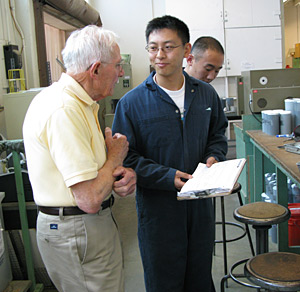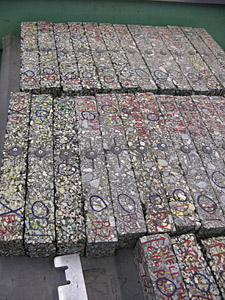For six decades he’s paved the way for a smoother ride

Often it’s only an unexpected pothole or a bumpy road that draws our attention to pavement conditions. But for civil and environmental engineering professor Carl Monismith (B.S.’50, M.S.’54 CE), the ups-and-downs of pavement have been worth his ongoing consideration for the past 60 years.
As the co-director of the Pavement Research Center (PRC), Monismith has been studying pavement design and technology since 1951.
He began his career at Berkeley at the Institute of Transportation and Traffic Engineering (now the Institute of Transportation Studies). Funded by the state legislature in 1948, the institute was tasked with researching pavement materials and design for California’s massive highway construction program that was initiated after World War II.
The PRC was eventually established as a separate center in the late 1980s. Today, it is a multi-campus unit jointly operated by Berkeley and UC Davis, where researchers continue to work with Caltrans to develop and evaluate materials for the state’s roads. Their work, says Monismith, is just as critical today as it was more than half a century ago, when the center was developing pavement technologies for the state’s modern freeway system.
“In the United States, we spend over $100 billion a year on pavements,” he says. “Well-designed roads are very important to the people and economy of California, and it’s important in these times to make certain that we use materials very effectively.”
The economic and environmental impacts of what we perceive as relatively benign road conditions can be far-reaching, he says. Take, for example, a bumpy road. What seems as merely annoying to the commuter can be costly when it comes to freight transport, where goods can be jostled and damaged. The result? Damage to the truck, further deterioration of the road and the use of costly packaging—which later must be disposed of or recycled—to protect the goods.
So when it comes to research, Monismith and his team at the PRC must think beyond the obvious, weighing numerous considerations as their focus has shifted from building new highways to maintaining existing roadways. Materials need to be economical, efficient and durable. But they must also mitigate the broad impact of transportation on the environment.

As such, the PRC’s projects span a wide range of areas, from smoother and longer-lasting pavements to the use of recycled materials such as used tires or reclaimed materials from old roads. The center also develops life cycle assessments—systems for tracking pavement performance on highways throughout the state.
At the PRC, all new asphalt and concrete technologies undergo a rigorous testing process that measures their performance and durability. Researchers create samples from a mix of materials and then subject these specimens to testing using machines that can simulate extreme temperatures, varying weather conditions and even the impact of millions of vehicles. Researchers also collect core samples from existing highways for further evaluation in the lab. Since 1993, all data has been entered into a database for Caltrans to use for planning construction and repairs.
Ultimately, says Monismith, their work is a continuous, meticulous process of building knowledge over time.
“There are no revolutionary things that happen, it’s all evolutionary things that happen,” he says. “We learn from our mistakes and improve.”
Monismith epitomizes that type of steady, painstaking approach in his own work, says John Harvey (M.S.’89, Ph.D.’92 CE), professor of civil engineering at UC Davis and co-director of the PRC. In addition to being a passionate and prolific researcher, Monismith is a mentor to the 50 or so students who conduct research at the PRC each year.
“Carl is super knowledgeable and has never rested on his laurels,” Harvey says. “He is always identifying the important research questions and teaching students how to formulate their own questions.”
When not working on the pavements of tomorrow, Monismith is taking a look back, compiling a detailed history of Berkeley’s civil and environmental engineering department, which was established in 1872. The history, still a work-in-progress, not only highlights the engineers who helped build California, but is also a reminder of why, for over 60 years, Monismith has called UC Berkeley home.
“I couldn’t have picked a better job or better people to work with,” he says. “The people are what make this university great.”
